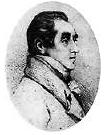Charles Hatchett
Charles Hatchett (born February 1, 1765 in London , † October 3, 1847 ibid) was an English chemist and mineralogist .
Live and act
Hatchett was born the son of a well-known coach builder. As a young man he took the opportunity to personally deliver a carriage for Catherine the Great in Saint Petersburg . During this trip his interest in chemistry and mineralogy developed .
Hatchett discovered the element niobium in 1801 when he analyzed a sample of columbite on behalf of the British Museum in London . He named the element Columbium in honor of Christopher Columbus , the discoverer of America, which can be found in the Anglo-Saxon-speaking area. T. has held until today. On November 26, 1801, he presented his discovery to the Royal Society . Hatchett's discovery could not be confirmed until after his death, when Heinrich Rose rediscovered niobium. However, since he was not aware of Hatchett's work, he named the newly found element niobium .
In addition to the discovery of niobium, Hatchett made several other discoveries in the field of mineralogy between 1796 and 1806. He later served as Vice President of the Royal Institution of Great Britain . In 1797 he was elected a Fellow of the Royal Society .
In order to be able to devote himself completely to the family business, he later retired from chemistry. He was now known as a collector of old books, art, and music manuscripts and instruments.
Honors
In 1798 he was awarded the Copley Medal . In 1797 he became a Fellow of the Royal Society of Edinburgh . In 1808 he was elected a foreign member of the Bavarian Academy of Sciences . In September 1823 he became a corresponding member of the Académie des Sciences . The Charles Hatchett Prize, which has been awarded since 1979 for research and development with and about niobium, is named after him.
Individual evidence
- ↑ William P. Griffith, Peter JT Morris: Charles Hatchett FRS (1765-1847), Chemist and Discoverer of Niobium . The Royal Society Publishing. September 22, 2003. Retrieved February 12, 2015.
- ^ Robert Jameson: System of Mineralogy, Vol. II . Bell and Bradfute (et al.). 1805. Retrieved on February 15, 2015: “… Mr Hatchett found it to contain a metal, which, from its properties, could not be referred to any hitherto known; hence he was of opinion that it should be considered as a new genus, to which he gave the name Columbium, in honor of the discoverer of America . (Mr. Hatchett realized that it contained a metal that, by virtue of its properties, could not be assigned to any previously known; therefore he was of the opinion that it should be considered as a new species, which he named Columbium in honor of the discoverer of America .) ... "
- ^ Charles Hatchett: An Analysis of a Mineral Substance from North America, Containing a Metal Hitherto Unknown . In: Philosophical Transactions of the Royal Society of London . 92, 1802, pp. 49-66. doi : 10.1098 / rstl.1802.0005 .
- ↑ Charles Hatchett: Properties and chemical behavior of the new metal discovered by Charles Hatchett, columbium . In: Annals of Physics . 11, No. 5, 1802, pp. 120-122. bibcode : 1802AnP .... 11..120H . doi : 10.1002 / andp.18020110507 .
- ↑ member entry by Charles Hatchett (with photo) at the Bavarian Academy of Sciences , accessed on February 6, 2016th
- ^ List of members since 1666: Letter H. Académie des sciences, accessed on November 23, 2019 (French).
Web links
- The Charles Hatchett Award
- The history of the discovery of niobium (English) ( Memento of 18 June 2013 Internet Archive )
| personal data | |
|---|---|
| SURNAME | Hatchett, Charles |
| BRIEF DESCRIPTION | English chemist |
| DATE OF BIRTH | February 1, 1765 |
| PLACE OF BIRTH | London |
| DATE OF DEATH | October 3, 1847 |
| Place of death | London |
